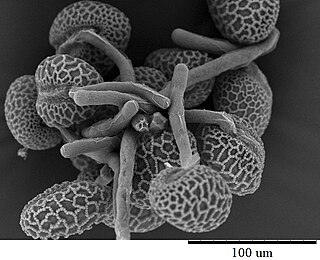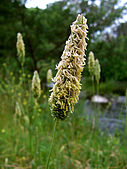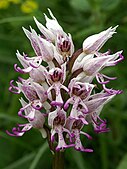
A gametophyte is one of the two alternating multicellular phases in the life cycles of plants and algae. It is a haploid multicellular organism that develops from a haploid spore that has one set of chromosomes. The gametophyte is the sexual phase in the life cycle of plants and algae. It develops sex organs that produce gametes, haploid sex cells that participate in fertilization to form a diploid zygote which has a double set of chromosomes. Cell division of the zygote results in a new diploid multicellular organism, the second stage in the life cycle known as the sporophyte. The sporophyte can produce haploid spores by meiosis that on germination produce a new generation of gametophytes.

Fertilisation or fertilization, also known as generative fertilisation, syngamy and impregnation, is the fusion of gametes to give rise to a zygote and initiate its development into a new individual organism or offspring. While processes such as insemination or pollination, which happen before the fusion of gametes, are also sometimes informally referred to as fertilisation, these are technically separate processes. The cycle of fertilisation and development of new individuals is called sexual reproduction. During double fertilisation in angiosperms, the haploid male gamete combines with two haploid polar nuclei to form a triploid primary endosperm nucleus by the process of vegetative fertilisation.

Alternation of generations is the predominant type of life cycle in plants and algae. In plants both phases are multicellular: the haploid sexual phase – the gametophyte – alternates with a diploid asexual phase – the sporophyte.

In botany, apomixis is asexual development of seed or embryo without fertilization. However, other definitions include replacement of the seed by a plantlet or replacement of the flower by bulbils.

Pollination is the transfer of pollen from an anther of a plant to the stigma of a plant, later enabling fertilisation and the production of seeds. Pollinating agents can be animals such as insects, for example beetles or butterflies; birds, and bats; water; wind; and even plants themselves. Pollinating animals travel from plant to plant carrying pollen on their bodies in a vital interaction that allows the transfer of genetic material critical to the reproductive system of most flowering plants. When self-pollination occurs within a closed flower. Pollination often occurs within a species. When pollination occurs between species, it can produce hybrid offspring in nature and in plant breeding work.

The Buxales are a small order of eudicot flowering plants, recognized by the APG IV system of 2016. The order includes the family Buxaceae; the families Didymelaceae and Haptanthaceae may also be recognized or may be included in the Buxaceae. Many members of the order are evergreen shrubs or trees, although some are herbaceous perennials. They have separate "male" (staminate) and "female" (carpellate) flowers, mostly on the same plant. Some species are of economic importance either for the wood they produce or as ornamental plants.

The gymnosperms are a group of seed-producing plants that includes conifers, cycads, Ginkgo, and gnetophytes, forming the clade Gymnospermae. The term gymnosperm comes from the composite word in Greek: γυμνόσπερμος, literally meaning 'naked seeds'. The name is based on the unenclosed condition of their seeds. The non-encased condition of their seeds contrasts with the seeds and ovules of flowering plants (angiosperms), which are enclosed within an ovary. Gymnosperm seeds develop either on the surface of scales or leaves, which are often modified to form cones, or on their own as in yew, Torreya, Ginkgo. Gymnosperm lifecycles involve alternation of generations. They have a dominant diploid sporophyte phase and a reduced haploid gametophyte phase which is dependent on the sporophytic phase. The term "gymnosperm" is often used in paleobotany to refer to all non-angiosperm seed plants. In that case, to specify the modern monophyletic group of gymnosperms, the term Acrogymnospermae is sometimes used.

The embryophytes are a clade of plants, also known as Embryophyta or land plants. They are the most familiar group of photoautotrophs that make up the vegetation on Earth's dry lands and wetlands. Embryophytes have a common ancestor with green algae, having emerged within the Phragmoplastophyta clade of freshwater charophyte green algae as a sister taxon of Charophyceae, Coleochaetophyceae and Zygnematophyceae. Embryophytes consist of the bryophytes and the polysporangiophytes. Living embryophytes include hornworts, liverworts, mosses, lycophytes, ferns, gymnosperms and angiosperms. Embryophytes have diplobiontic life cycles.

A pollen tube is a tubular structure produced by the male gametophyte of seed plants when it germinates. Pollen tube elongation is an integral stage in the plant life cycle. The pollen tube acts as a conduit to transport the male gamete cells from the pollen grain—either from the stigma to the ovules at the base of the pistil or directly through ovule tissue in some gymnosperms. In maize, this single cell can grow longer than 12 inches (30 cm) to traverse the length of the pistil.

In seed plants, the ovule is the structure that gives rise to and contains the female reproductive cells. It consists of three parts: the integument, forming its outer layer, the nucellus, and the female gametophyte in its center. The female gametophyte — specifically termed a megagametophyte— is also called the embryo sac in angiosperms. The megagametophyte produces an egg cell for the purpose of fertilization. The ovule is a small structure present in the ovary. It is attached to the placenta by a stalk called a funicle. The funicle provides nourishment to the ovule.On the basis of the relative position of micropyle, body of the ovule, chalaza and funicle, there are six types of ovules . (a) Orthotropous ovule - the micropyle, chalaza and funicle all lie in the same straight line, this is the most primitive type of ovule . Eg: Piper, polygonum and cycas.

The endosperm is a tissue produced inside the seeds of most of the flowering plants following double fertilization. It is triploid in most species, which may be auxin-driven. It surrounds the embryo and provides nutrition in the form of starch, though it can also contain oils and protein. This can make endosperm a source of nutrition in animal diet. For example, wheat endosperm is ground into flour for bread, while barley endosperm is the main source of sugars for beer production. Other examples of endosperm that forms the bulk of the edible portion are coconut "meat" and coconut "water", and corn. Some plants, such as orchids, lack endosperm in their seeds.

Plant reproductive morphology is the study of the physical form and structure of those parts of plants directly or indirectly concerned with sexual reproduction.
Dioecy is a characteristic of certain species that have distinct unisexual individuals, each producing either male or female gametes, either directly or indirectly. Dioecious reproduction is biparental reproduction. Dioecy has costs, since only the female part of the population directly produces offspring. It is one method for excluding self-fertilization and promoting allogamy (outcrossing), and thus tends to reduce the expression of recessive deleterious mutations present in a population. Plants have several other methods of preventing self-fertilization including, for example, dichogamy, herkogamy, and self-incompatibility.

Bennettitales is an extinct order of seed plants that first appeared in the Permian period and became extinct in most areas toward the end of the Cretaceous. Bennettitales were amongst the most common seed plants of the Mesozoic, and had morphologies including shrub and cycad-like forms. The foliage of bennettitaleans is superficially nearly indistinguishable from that of cycads, but they are distinguished from cycads by their more complex flower-like reproductive organs, at least some of which were likely pollinated by insects.

The eudicots, Eudicotidae, or eudicotyledons are a clade of flowering plants (angiosperms) which are mainly characterized by having two seed leaves (cotyledons) upon germination. The term derives from dicotyledon. Previously, they were called tricolpates or non-magnoliid dicots by past authors. The current botanical terms were introduced in 1991, by evolutionary botanist James A. Doyle and paleobotanist Carol L. Hotton, to emphasize the later evolutionary divergence of tricolpate dicots from earlier, less specialized, dicots.

In the flowering plants, an ovary is a part of the female reproductive organ of the flower or gynoecium. Specifically, it is the part of the pistil which holds the ovule(s) and is located above or below or at the point of connection with the base of the petals and sepals. The pistil may be made up of one carpel or of several fused carpels, and therefore the ovary can contain part of one carpel or parts of several fused carpels. Above the ovary is the style and the stigma, which is where the pollen lands and germinates to grow down through the style to the ovary, and, for each individual pollen grain, to fertilize one individual ovule. Some wind pollinated flowers have much reduced and modified ovaries.

Double fertilization or double fertilisation is a complex fertilization mechanism of flowering plants (angiosperms). This process involves the joining of a female gametophyte with two male gametes (sperm). It begins when a pollen grain adheres to the stigma of the carpel, the female reproductive structure of a flower. The pollen grain then takes in moisture and begins to germinate, forming a pollen tube that extends down toward the ovary through the style. The tip of the pollen tube then enters the ovary and penetrates through the micropyle opening in the ovule. The pollen tube proceeds to release the two sperm in the embryo sacs.
Plant taxonomy is the science that finds, identifies, describes, classifies, and names plants. It is one of the main branches of taxonomy.

A flower, also known as a bloom or blossom, is the reproductive structure found in flowering plants. Flowers consist of a combination of vegetative organs – sepals that enclose and protect the developing flower, petals that attract pollinators, and reproductive organs that produce gametophytes, which in flowering plants produce gametes. The male gametophytes, which produce sperm, are enclosed within pollen grains produced in the anthers. The female gametophytes are contained within the ovules produced in the carpels.
Plant reproduction is the production of new offspring in plants, which can be accomplished by sexual or asexual reproduction. Sexual reproduction produces offspring by the fusion of gametes, resulting in offspring genetically different from either parent. Asexual reproduction produces new individuals without the fusion of gametes, resulting in clonal plants that are genetically identical to the parent plant and each other, unless mutations occur.
























































